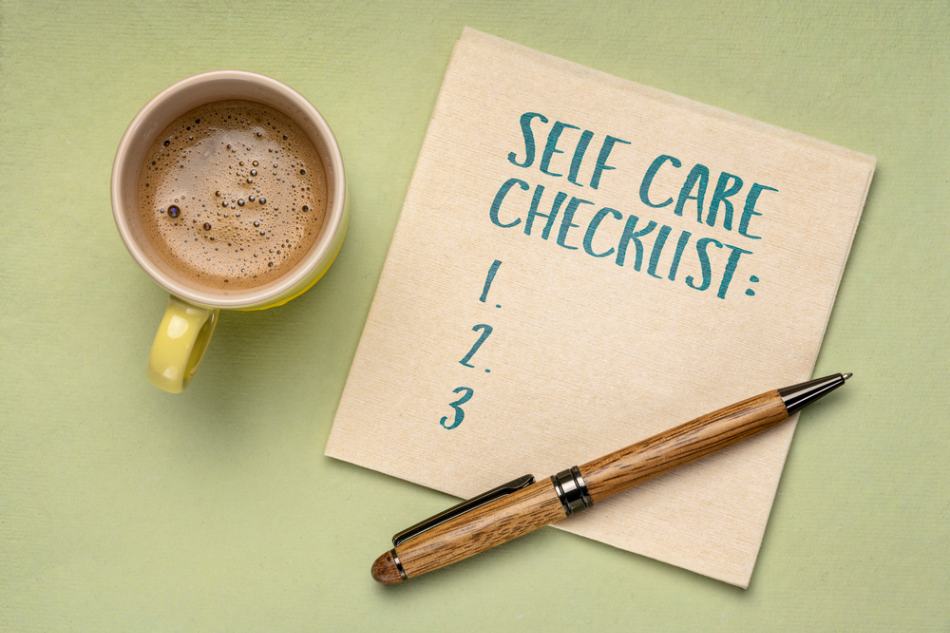May 14, 2020
Webinar: Tools for Managing Anxiety Related Intrusive & Obsessive Thoughts
Written by Rachel Eddins
Posted in Anxiety, Webinars and with tags: Anxiety, Social Anxiety, understand anxiety

Do you or someone you know suffer from anxiety? Have panic attacks?
Join us in learning ways anxiety can overwhelm our daily lives and strategies to combat these intrusive thoughts.
Facilitated by Sarah Soto.
Watch a replay of the presentation here.
Learn more about our anxiety treatment services.
Here is a transcript of the webinar:
My name is Sarah Soto and I am a licensed professional counselor here at Eddins Counseling Group. I do EMDR therapy so I specialize in trauma therapy, but I also do a lot of work with anxiety.
What we’re going to be focusing on today specifically is how to manage thoughts related to anxiety. We’re going to do this in a little bit of a story form, and then we’re going to throw in some tips and things that we can do in between there.
Agenda
The first thing I want to talk about is what parts of anxiety we’re going to be covering today. So when I’m talking about intrusive thinking patterns, what I mean is the thoughts that just pop up into your head out of nowhere that are either related to something that’s happening now or thoughts that are seemingly unrelated in the stuff that we just think of whenever.
Obviously intrusive thoughts in this situation are ones that are more geared toward feelings of anxiety and not necessarily intrusive thoughts like unicorns and rainbows.
Then we’re going to get into how sometimes those intrusive thoughts we can get into like loops where it feels like chaos depending on how fast it is, but mostly a feeling of not being able to get out of the intrusive thought once you are into it.
A “Chocolate Factory” Exercise
I wanted to start today with a little bit of an exercise and what we’re going to do is like an “I Love Lucy” thing. So this is actually a little bit of a mindfulness technique.
There’s an episode of “I Love Lucy” where she’s working at a chocolate factory and there’s a conveyor belt that comes around with different chocolates on it and it starts happening faster, faster, faster. She ends up putting the chocolates in her hat and down her shirt. It’s an iconic “I Love Lucy” moment.
For this exercise, I’m going to start by having us take one minute. During that time, I want you to imagine that each chocolate on the conveyor belt, as it is passing you by, is a thought. So let’s say we started this exercise and then all of a sudden, I had a thought: “I’m hungry”.
We grab the thought and we kind of put it on to the chocolate and we decide in those moments:
- “Is this something that I want to pick up and chew on or stuff in my hat or put down my shirt?” … OR …
- “Is this something that I’m just going to let go by?”
One thing about anxiety that’s really important to remember is that even though there are thoughts that “my anxiety is a normal feeling”, we don’t have to believe everything that we think.
A Thought is Just a Thought

Being able to challenge the things that are coming up for you is really important because it helps you identify where you want to put your energy, but also it helps you pick what things you might want to reframe. And that’s something we’re going to be going over also.
Now take the next minute to yourself, if that’s something that you want to participate in, close your eyes and take a deep breath. Then I want you to focus on just one thing, your breathing. As you noticed, thoughts are likely coming up. And they will because distraction is normal and intrusive thoughts are also normal. Then I want you to place the thought on the chocolate and then let it go by.
My first question for you is: (I’m only going to answer questions as they come up) Did anybody notice anything interesting while they were noticing their thoughts go by?
If you didn’t have thoughts, that’s ok. That would just mean that you were able to focus on your breath or focus on the exercise, and then that’s good. If you did have thoughts that were intrusive for you, continuing to practice the exercise is something that helps you become more aware of your thoughts as something that you watch instead of something that just overwhelms you.
Metacognition
Metacognition is the idea of having thoughts about your thoughts and it’s an important way to start to manage anxiety, because when we are unaware of what impact thoughts have on our behaviors and our emotions, then we are less able to figure out how we can reframe them.

“Let’s Pretend” Exercise
The thing that we’re going to do next is we’re going to play a little game called “Let’s Pretend”. So we’re going to walk through some situations in which I might talk to clients or things that people have told me about that they’ve been kind of anxious about and how we might work on working through those things.
The first thing we’re going to do is pretend we’re at a grocery store. I know that some of these scenarios aren’t going to be applicable to everybody. But the idea is that you can use any intrusive thought with these exercises and they’ll still apply.
Let’s pretend we’re at a grocery store and you’re there looking for a head of lettuce because somebody sent you for some and you can’t find a thing that you’re looking for specifically. You have to ask somebody, except that the idea of asking somebody to help you with something makes you feel anxious.
So maybe when you would come in to talk to me, what you would say is: “I’m having trouble asking people for things. This isn’t something that I’m very comfortable with. I don’t want to burden anybody with anything.” You might be asking yourself:
- What if they’re mad?
- What if they’re angry?…”
These are thoughts that we have in our head that we generally don’t talk about out loud but are still important to really get into at your therapy session.
What we would then work on is identifying cognitive distortions.
Cognitive Distortions
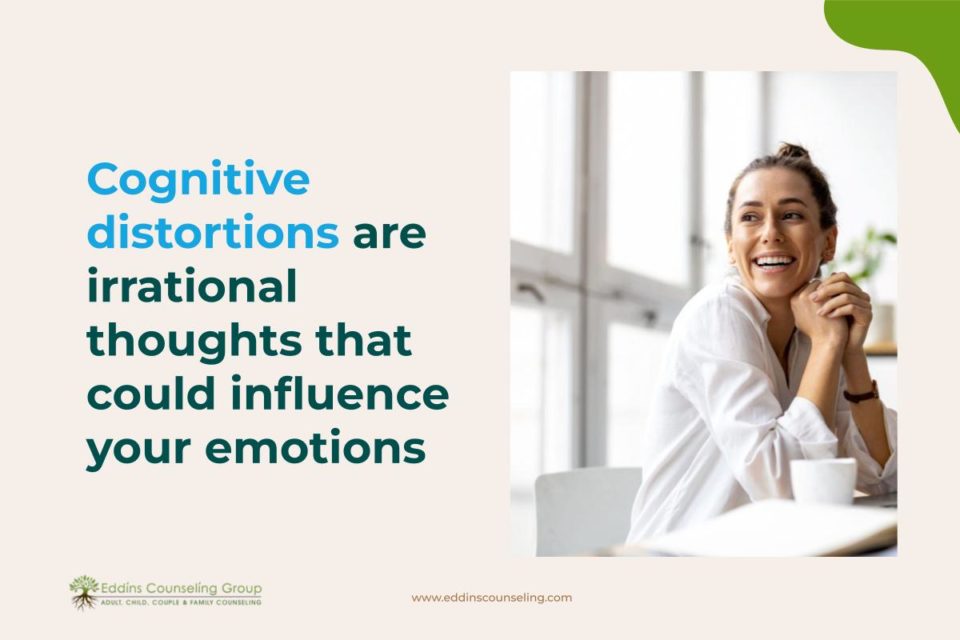
Cognitive distortions are the irrational thoughts that we have that can influence our emotional state.
An example in that story about cognitive distortion would be the automatic thought that if you ask somebody a question, that would be burdening them. If that’s something that you came to me with, that’s what I would identify with that.
I’m not saying that it’s not possible that you would be, because I also recognize that when people have anxiety, it’s not like anxiety that comes out of nowhere or anxious thoughts that don’t make any sense. For example, I have anxiety for my entire life. One thing I know is that for people who have anxious thoughts, it’s relevant. Of course, you could be a burden that could definitely happen.
We’re not trying to take away from the experience or the thoughts that you might have that could be true.
The reason that we don’t try to do that is that nobody would believe it. If I told you I thought the worst-case scenario was going to happen and you told me it definitely wasn’t, I would say: “Ok, sure it wasn’t.” But in my head, I would think that it could happen. So that’s not very helpful.
We’re not trying to get to a place that’s like unicorns and rainbows, but we do want to get to a spot where we can challenge our thoughts into a place where we at least decrease the amount of anxiety that we’re experiencing so that it’s manageable or tolerable, or so that we give ourselves a chance to see what options there are for us.
So How Do You Identify a Cognitive Distortion?
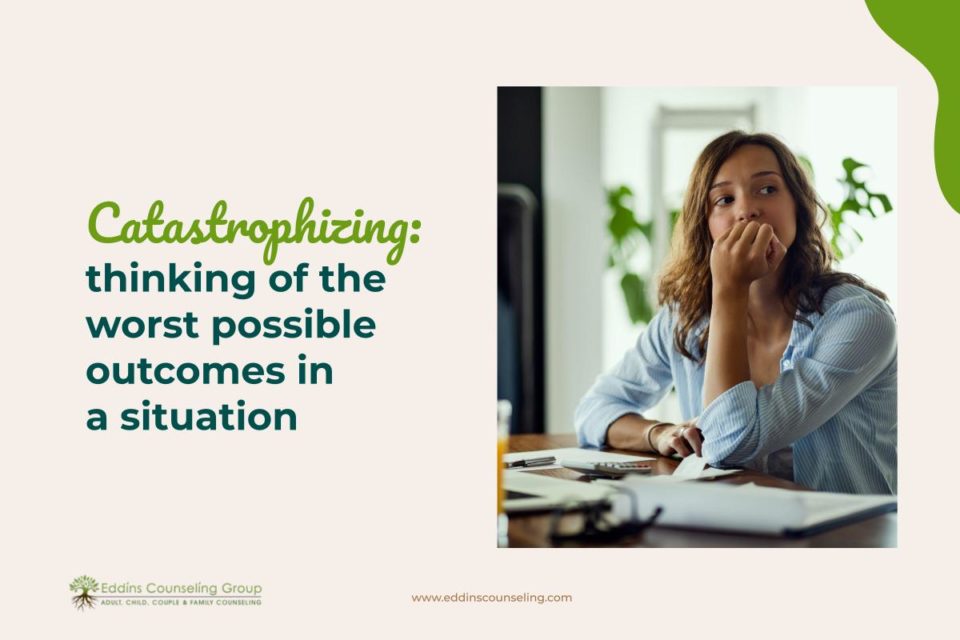
If you came into the session and you were telling me that you were having an experience, you were having some trouble like that, what we would do is identify what the cognitive distortion was.
In this instance, it might be like catastrophizing, thinking of only the worst possible outcomes of a situation.
It could be for fortunetelling, like believing that you can tell the things that are going to happen or if you ask somebody something, they would look at you and say: “Absolutely not”, which is something that when we have anxiety, we think is definitely a possibility that could happen.
A Catastrophizing Exercise
One of the exercises that we can use is three positive or neutral options for something else that could happen.
I know this is at a low scale. When you’re going to ask somebody something, the idea: “They’re not going to want to help me if I ask this. I should know how to find it myself” (whatever it is that comes up), the positive or neutral options could be something like:
- “I could ask them and everything might be ok” or …
- “I could ask them and they could help me get to the thing I want” or …
- “I could ask them and maybe they would say no” … and then what would happen to me then?”
We question what other possibilities could happen instead of the things that we are sure about.
The first time I learned about all of this was from another therapist who taught me, actually. I was dating somebody who wasn’t answering his phone. This is normally not a really big deal, but it was for me because of things that have happened in my past. This is true with a lot of people with anxiety and that’s what I mean when I say that this stuff isn’t coming from anywhere.
People experience anxiety because bad things have happened.
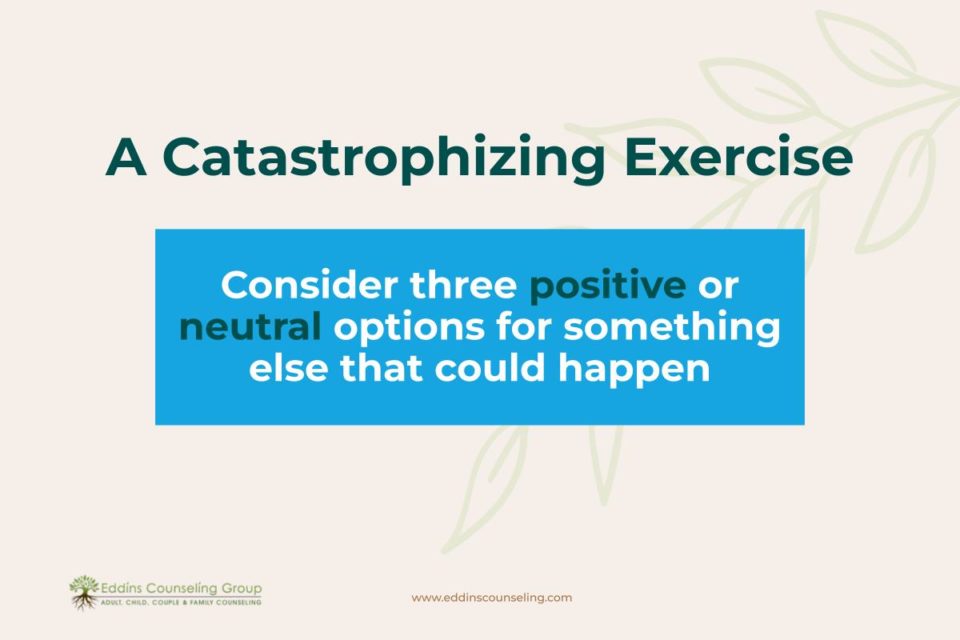
Ask Yourself: What Else Could Happen?
The issue then is that our brains might jump to extremes of bad things happening where they might not need to based on the exact situation. So, I imagined in my head that bad things were happening, like he is dead or got arrested, even though I had no idea.
And my therapist asked: “What else could happen?”
I replied: “I don’t know. I told you the options are jail, dead, etc.”
And she wanted to know other options. I added: “I don’t know, maybe he’s stuck in a ditch somewhere.”
Then, she said: “Maybe you can think of something else.”
I thought: “Maybe his phone could be dead, I guess.”
Even just challenging myself in those moments was kind of challenging.
This isn’t necessarily going to be something that makes you feel 100% better, but it can definitely help you start to question the immediate belief about the thing you think is definitely going to happen.
That’s important in anxiety because people with anxiety, although we are very good at telling when tones change, faces change, or when somebody comes into the room where you feel that your energy is off, we have tendencies toward jumping to conclusions. And because we jump so quickly, our answer is sometimes wrong.
What Does Your Face Tell Me?
When people with anxiety see somebody come in and they have an angry face, they ask:
- You have an angry face. Did something happen?
- Did I do something?
- Are you mad at me?
- Did I forget something?”
They can tell that something is happening, but a good technique would be to wait a little bit longer. Waiting a little bit longer and trying to assume that it might not actually have anything to do with you. People can have their own emotional states that don’t affect ours, except when we are in an anxious state. That’s not really how we might see things.
Let’s say I was a parent or I was taking care of somebody. For example, I was in the middle of a grocery store and my kid starts throwing a fit. This is something that kids do or they start crying or they’re upset or they want something and then I’m upset. And then people start looking at us because the kid is crying and all of a sudden I’m flooded with intrusive thoughts about what these random people might be thinking:
- (They must be thinking that… ) I’m not doing a good job as a parent.
- I’m a bad parent.
- I don’t know how to discipline my kid or that maybe we should leave.
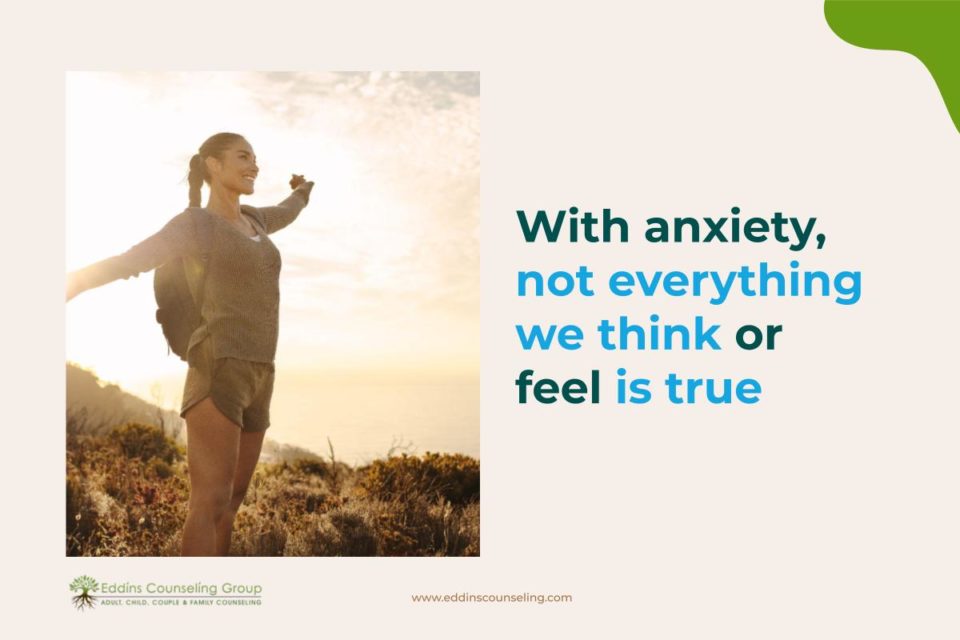
“For” / “Against” The Thought
You have all these thoughts about all of the things that people could think about us. And if that’s something that you struggle with, one of the things you can do in that situation is figuring out what evidence you have “for” or “against” the thought that you’re having.
For
Let’s say that in that situation, your evidence “for” that thing happening would be that people are looking at you. So in session, what we would do is talk about what happened and why did you think that people would be mad at you. That’s your evidence “for”.
Against
And if we did evidence “against” it could also be about what other things could have happened. Is it possible that they’re looking at you because they also have kids and they empathize with the situation or that they started looking in your direction because they heard a noise and that’s generally what people do?
They could also be looking in your direction, but in a few minutes, you’re not going to be in that situation anymore and you’re never going to see those people again. Those are the ways we kind of move through this.
Evidence-Based Cognitive Behavioral Techniques
Another way that you can work on “evidence-based cognitive behavioral techniques” is let’s say that you have an intrusive thought that just comes up out of nowhere. Something that you’re afraid will happen.
For example, if you’re going to a party or you’re walking into a room of people and you have a thought that you could say something dumb and afterward, you’re thinking:
- Now nobody likes me … or
- People aren’t going to like me … or
- They’re mad at me … or
- Nobody is going to invite me to anything anymore because I’m so awkward all the time.
What we would do next is think about what is your evidence that people are mad at you.
What is Your Evidence That… ?
And sometimes we have something and sometimes we don’t. But if you also had something then what was your evidence that they weren’t? It could be options like they didn’t actually say that they were mad at you or something like they have invited you to things before, and so what would be the reason that they wouldn’t any more or that you’ve been friends with them for a really long time. Maybe they could be mad about something else, it didn’t have anything to do with you.
There are a lot of options here for ways that you can play essentially a lawyer. In that game, you’re playing lawyer, lawyer, and judge. You are ultimately the person that gets to decide what seems like it’s backed by evidence and what seems like it’s not.
One of the really important things we have to remember in anxiety is that not everything we think is true and not everything we feel is true.
That doesn’t mean it’s not valid or that we don’t accept the thought and sit with it and allow that to pass naturally. But that also means that managing our thoughts can help decrease the feelings of anxiety that we get in those moments.
I’m trying to pool ideas from things that I hear people talk about a lot. So that’s one of the reasons that I went with something where people would be mad at me because I think one of the major things that people have anxiety with or around is in relation to our relationships with people and our ability to say no, as well as the expectations that we have for ourselves.

Intrusive Thinking Patterns
If we then move into intrusive thinking patterns, some of these things don’t happen from an actual event. These are just thoughts that pop into your head. One of the things I notice when people first start to come to talk to me about intrusive thinking patterns is that they are afraid that there’s something wrong with them for the thoughts that they’re having that are intrusive.
It can be that there’s something wrong about them or something wrong about somebody that you were in a relationship with. But everybody thinks of all kinds of things all the time. Whatever thought you have is ok.
If you’re able to accept thoughts as just thoughts, then it takes away some of the pressure that you feel from having that. Because if we just add “I’m anxious about the anxious thought that I had”, we’re just building anxiety onto what it is that we’re doing.
So give yourself a little grace in those moments and recognize that we don’t have any control over the thoughts that pop up in our head, which I know because I have tried to do and it is not effective. And also because in anything that I’ve read, we just don’t.
We don’t have control over the first thought that pops in. But sometimes we can build second automatic thoughts onto the first thoughts.
Cognitive Distortions, Part 2
Cognitive distortions are irrational thoughts that could influence your emotions. As a side note, there’s a list you can Google on cognitive distortions anywhere. It’ll have stuff like:
- Catastrophizing (which is the thinking worst-case situation),
- Fortune telling,
- Mind reading (believing that we know what we feel or what other people are thinking without asking them about anything), or
- Feeling like you did a bad thing, therefore, you must be a bad person.
There’s a list of about ten of them. We’re not going to overview all of them right now. But I wanted to list a really good resource if it’s something that you wanted to look into.
Reframing Cognitive Distortions

Reframing Cognitive Distortions is an amazing skill.
There’s an app called Sanvello. It has a list of the distortions in the heart of the app that has thoughts, and it will walk you through ways to reframe cognitive distortions. That’s really helpful.
While you’re learning to do this, it’s important to really sit with it, especially in the first couple of weeks, because what of something that happens when we build anxious thoughts? This is something that I’m assuming a lot of people have been doing for their whole life. You are not strangers to anxiety.
So that means that the neural connections taught anxious thoughts are strong. Like every time we do what we build, we strengthen the connection. So when we start to question that, it’s like slowly turning a wheel that has been turning for the entire time you have been experiencing these kinds of thoughts.
In challenging these distortions, what we’re doing is trying to slowly turn the wheel the other way so we can strengthen neural connections toward reframing the thought.
(Or seeing if there’s any evidence for it, or questioning if there are other options.)
But since we haven’t thought that way in a long time, it takes a little bit of work to get to it. Eventually you’ll be able to do more in your head and then use reframing exercises for things that you might need to write down. If it’s really serious, you’re kind of getting jumbled in your thoughts and you’re having trouble identifying the thing that is making you anxious.
Start with something small that you’re anxious about.
Like, for example, you’re anxious about sending back food that you ordered that came back wrong. I think that’s something that people experience anxiety about. So and in your head, you’ll think: “I can’t turn it back. It’s rude. Sending back this food seems rude and then they’re going to be mad at me. And then what if they go into the kitchen and they told the guy in the kitchen and then they are mad at me and then I can never come back to this place”.
I know that that’s how anxious thoughts work. Sometimes we’re not aware that that’s what’s happening, but that’s the places that we get to. We assume so many things about what’s going to happen step by step.
In using cognitive distortions to reframe things we can identify our thoughts.
My thing was: “I don’t want to send the food back because then the waitress will be mad at me.” That’s a reframe there because there could also be other options for what could happen. Yes, she could be mad or she could be totally cool because people send back food at places all the time. Or she could be mad and then she could tell the chef and then maybe the chef will be mad or maybe he will just say: “Oh, my bad. That was the wrong thing. Let’s see what happens now.” Or nothing could happen.
We have to challenge that so that we’re able to kind of move toward more behaviors that we would like to do. Letting our anxiety lead all of our choices and our behaviors is exhausting and anxiety is exhausting anyway. So giving ourselves a chance to experience other opportunities can be really helpful in managing that.
A Real Life Example of Anxiety in the Workplace

Another example that I thought of was let’s say you have a meeting with your boss and they just sent you an email and it said: “Hey, can I talk to you at once? I booked an appointment with you.”
So, first, your heart starts beating faster and then you start getting tense. Then the thoughts are:
- Did I do something wrong?
- Did I do what I was supposed to do?
- Is she going to fire me?”
So your thoughts jump from “I need a meeting” to “I’m going to get fired and live on the streets, possibly be homeless, and this is the end for me”. And that’s how anxiety works.
Another important thing when you’re trying to manage anxious thoughts is that you have to get to the part at the end of the anxious thought.
If we don’t get to the part where the answer is “Then I’m going to be fired”, it’s difficult. That’s part of the core fear: “I’m going to be fired. I’m not going to be able to provide it. This is going to be an issue with my family.”
But What Would Happen If… ?
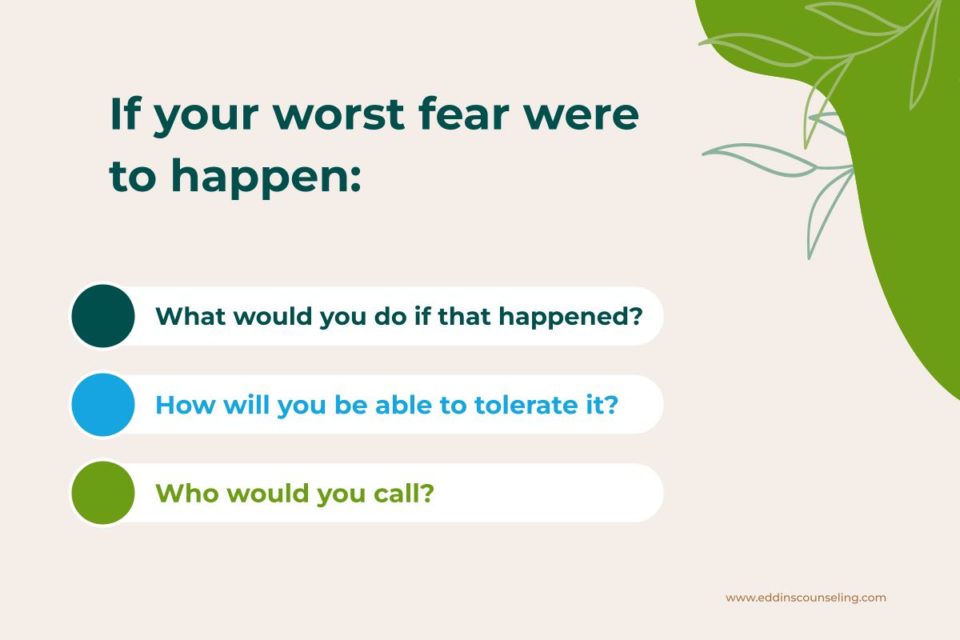
So we have to identify those things because that’s where some of the core issues are, in the fear of what we think the worst-case thing would mean for us. Once we get to that place, identifying the distortion can be helpful.
Let’s say you had a cognitive distortions list next to you. One of the things you can do is just put a list on your refrigerator, take a screenshot of your phone, and when you have an anxious look at the list and think: “Is anything I am thinking matching on this list?” If it does match this list, that might mean that it’s coming from a place of anxiety.
So you can look at the list and then you can see that it is definitely a cognitive distortion. It is falling on one of these lists. And in that minute you can do a breathing exercise or a grounding exercise or that’s where you can start to reframe or you can just identify that it is coming from a place of anxiety. How do you want to handle this? And give yourself a break that way.
Dealing With Covid
This is another thing that I thought maybe would be important for us to talk about so we can kind of pivot and then go in that direction. Let’s say, the issue you’re having with Covid is the moments when you have to go to the grocery store, have to run an errand, or have to go to work. Because there are a lot of people who are having to go back to work and there are a lot of people who are afraid because they’re not exactly ready or because it seems like maybe this isn’t the thing we’re supposed to be doing yet, and that is really scary for people.
Here’s one of the things you can do:
First is to acknowledge that fear and that anxiety are healthy.
It is ok for us to feel anxious to some amount and it’s ok for us to be afraid. But something that we can do is one, what can you do to prepare:
- Wear a mask,
- Wash your hands,
- Try not to touch your face,
- Follow the guidelines of what you’re supposed to be doing to keep yourself and others safe
But what if the issue is about what are you supposed to do about all the other people who aren’t practicing the same thing that you are? What you can do is recognize what it is that you are afraid of happening, what is the anxiety. “I’m going to go out and go to the grocery store, I’m going to touch the door, I’m going to talk to somebody. They’re not going to be standing six feet away from me. And then I’m going to catch a cold, but I’m going to bring it home and everything is going to be a disaster.” Or that maybe you would get sick or you would infect loved ones.
We’re still validating that these anxieties are healthy and that it’s ok that we have them.
If your fear was that you’re going to get somebody sick or you’re going to get sick, you could (and I’m sure you would have a lot of evidence that that would definitely be possible), know that there could also be possibilities that that could not happen. So, even sometimes just adding in the possibility that it couldn’t be helpful.
Figuring out what you would do if it did happen. If you did get sick, then what would happen? Then it would be terrible. Then what if I had to go to the hospital? But it’s kind of playing a game of like one-up where you go back and forth between like thinking up the worst possible situations and it’s like the worst anxiety game ever. And then you get to the end, which very possibly could be something you could die or your family could die. This is a really difficult one because of how scary it is right now.
The point of what I’m trying to tell you is that even though it sounds kind of crazy if we can get to the point where we identify what our biggest fear is and sit with that for a little while.
Figure out:
- What we would do if that happened?
- How will we be able to tolerate it?
- Who would we call?
Acknowledging that and also allowing yourself to prepare for it and giving yourself some other options for things that could happen, even if you feel like they’re unlikely.
Sometimes when I’m in sessions and people say things like: “This seems very convincing”. Later, I also have to check myself and say: “Ok, but also it could not happen. Also, it could be okay. So, I could go back to work.” Somebody could try to get more than six feet close to me. And I could tell them: “Excuse me, you’re not respecting my personal distance.”
And then that might be another thing that we would have to work on. What if I told them that and they get mad but you are able to set your boundaries in that way? So it’s ok for you to do that in whatever way you need to so that you can feel safe.
Social Phobia(s)

Let’s talk about social phobia. From what I’ve seen, a lot of experience of social phobia has to do with our fear of what other people are going to think or do about us or about a situation or about something that we’ve done and beliefs that people aren’t going to like us, that they’re going to be mad at us or like different things are going to happen.
So for that specifically, the thing that I would suggest that someone do is, again, to look at that cognitive distortion list and in those trying to reframe it: write down sentences like “I’m going to go to this meeting and nobody is going to talk to me.”
So that might be fortunetelling. Because we don’t actually know if we go to the meeting that nobody will talk to us or it could be catastrophizing because we would automatically think of what the worst-case scenario was. It could also be mind reading, like knowing that we are next to somebody and thinking that because they look at us, that means that they don’t like us.
What you could do is set up the sentence in a way that’s like: “I could go to this meeting, and they could not talk to me or everything could go well and they could talk to me.” And so just like balancing out the thought, you give another thought the opportunity to exist there so that you can continue on that way.
What about morbid, intrusive thoughts that seem to be completely random?
We think thoughts like that all the time. There’s a book about obsessive-compulsive disorders, but it also had a list of all of the intrusive, morbid thoughts that people think most often. For example, when you’re driving in your car and think what would happen if your car just rammed into the side of the road? That would stop. Or if you have I thought about what if somebody dies? Or sometimes people will have thoughts that they are very ashamed of. What if somebody else is injured? I had a few clients that feel really ashamed when they have these kinds of thoughts. Things that come out of nowhere.
The really important thing to remember is that the thoughts are just thoughts and there are so many people who experience intrusive thoughts like that.
The ones that we think we can’t tell anyone because they’re going to think you’re crazy. Everybody has them. The more we get into accepting that as it is, it becomes a little bit lighter because we don’t have to carry it around like it’s something that we’re doing because our brain is crazy and we’re bad. Everybody thinks intrusive thoughts that come from all kinds of places, even when sometimes we think bad things about the people we love. That’s something that I’ve noticed that people experience also.
They’ll think something about their partner and then they will get thoughts like: “Oh my God, I can’t believe I thought that thing. Does that mean I don’t love them? Maybe I don’t like them anymore. Should we break up? Is this terrible? Am I a bad partner?”
But if you have that thought and then you’re able to just tell yourself: “I had that thought” and then move on to refocus on what you’re doing. I think this is an excellent way for us to segway into how you can refocus. The thing that happens when we have intrusive thoughts is that if we don’t catch them, then they become obsessive because of the way we think about them.
Refocus For One Minute

A really good exercise for that is grabbing anything that’s around you like a pen, a pot, a water bottle, or whatever, and then timing yourself for one minute and then for that one minute using your senses to describe what the thing is.
Like, for example, the object that I have in my arms. It’s cold and it’s white. And it clicks. It doesn’t smell like anything except my nail polish. Normally, if it was something we could taste, I would try to find out what it tastes like, but I’m not going to do this in front of everybody. We do a minute and then we go back to it. So, I’m describing this using all of my senses.
The thing is when we are able to pick something like this, something small and tactile, something that you can do on your own, in your class or in a meeting, just focus on that, using your senses for one minute.
What happens when we really focus on something is that we don’t get distracted by intrusive thoughts or obsessive thoughts, and we’re able to come back into the present.
You can do that with whatever. Sometimes because I have ADHD, this works well in people who have social anxiety too. Maybe not 100% on time, but based on the clients I’ve talked to, it seems like it’s pretty effective if you use this exercise with the person that you’re talking to.
Instead of doing it with this, I would look at whoever it is that I’m in the conversation with and I would focus on what their face looks like or what their mouth looks like when they’re talking or what their voice sounds like or what it is that they’re wearing.
And I would kind of lean in and try to refocus myself into the present, because one of the issues with anxiety, again, is that when we are in anxious thinking patterns, we are not with the people that we’re trying to be with.
This is because we’re in the future about things that might happen or things that have happened or happened in the past.
And so we’re not able to stay in the present with people because we’re following those anxious thoughts wherever it is that they’ll take us.
That exercise is really good for refocusing you on the conversation so that you don’t have to be in those anxious thoughts. This is not something that you’re going to do one time and then think you’re the focusing queen. Maybe I’m just saying that because I have ADHD.
So for me, I’ll do that, and then the intrusive thoughts come back. I’ll go to other places, then I’ll have to redo it again. So that’s something that you will continuously have to practice. But these are all things that you can use. These are all things that you can use in those moments, as needed.
Make A List of Techniques That Work for You

Another suggestion that I have for the exercise we talked about today is with your therapist or if you want to look on Pinterest or Google for some of these skills, like anxiety management techniques, make a list.
As you practice things, keep it on your phone or on a piece of paper and start listing the things that actually worked for you. So, for example, reframing works for me or grounding works for me or playing lawyer and judge works for me, or seeing if I have any evidence for the anxious thought works for me because I sometimes have no evidence at all for anything that happens a lot, etc.
You write down all of the things that happen and then you go through that. Just because something happened, something can work one time. If the anxiety is a really bad day, that one might not work this time. So then you have to go to the next one. Maybe this will work. So you go to the next one, maybe this will work, and then you are kind of switching back and forth.
You build up a kind of arsenal. Then in that, you have a lot of different ways to manage different things.
You can figure out what works the best for you and I’m sure that there have been things because you’ve been living with this for a long time that you’ve already learned can get you out of the places where you’re having trouble getting out of your head.
That’s something that’s been really useful for me personally. It’s something that I think is important for clients because not everything works all the time. Then we have some tools and eventually, something should work or could work or at least get you to 50% or a place that’s tolerable. Sometimes when our anxiety is at 10, we might not get to 0, but maybe we could get to 5, and then maybe we could get to 3.
Questions

What about trying to ignore the thought instead of coming up with more neutral thoughts? Aren’t you making thoughts important this way?
Even though it seems like the greatest thing to do for anxious thoughts or uncomfortable thoughts is to try to push them away, that doesn’t work. Let’s say you have intrusive thoughts about an ex and they keep popping up into your head and you’re like: “I can’t stop thinking about this freaking thing. This is so annoying!”. The more you say to yourself: “I’m not going to think about this. I’m not going to think about this. I’m not going to think about it. You’re still strengthening connections between you and thinking about the thing because you’re adding ”I’m not thinking about this thing”.
So that connection gets stronger. Instead, if you have the thought: “I’m thinking about my ex, or about whatever the intrusive thought is. Cool.” And then you just kind of let it go, kind of let it go. I know that’s easier said than done, but that’s like thinking about that. Then go back to the thing that you’re doing. If you allow it, it’ll give it less power. And then over time, the intrusive thought may show up less.
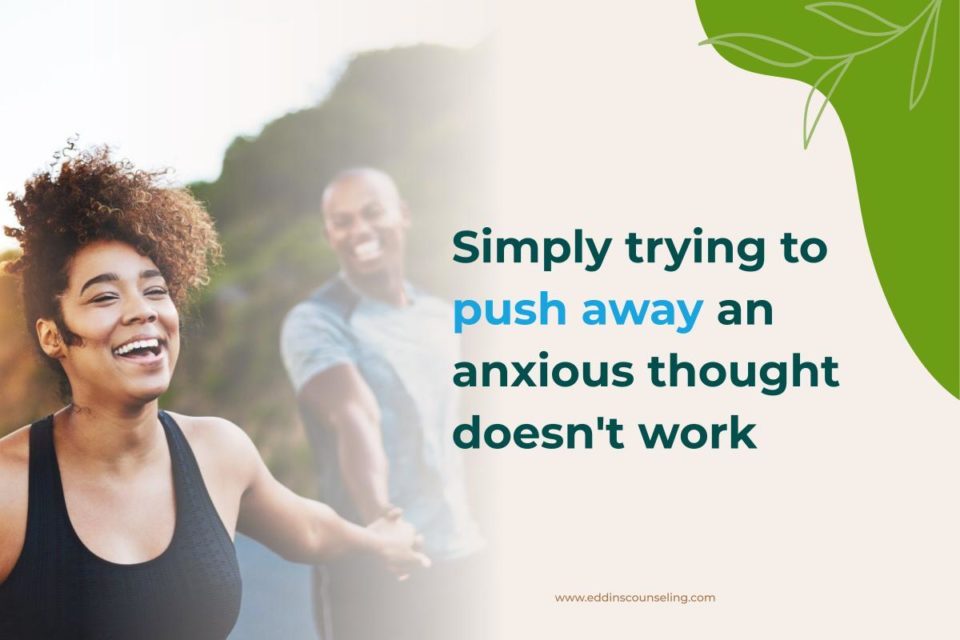
How do you stop fighting with a loved one when you are anxious and they don’t understand and want you to stop?
We cannot control other people’s responses to us. That’s just something that we can’t do, but we can control our own. So knowing that it is ok for you to be anxious is important. I know that sometimes we understand that and other people don’t. So maybe if you need a five-minute break, if they’re kind of talking to you about something that you’re uncomfortable with if they’re like demeaning the anxiety or invalidating it, I think that happens a lot with people, we can also use direct communication to tell people what we need in these moments.
That’s another really good thing. So when we’re anxious, sometimes what happens is that we need something. When we’re talking to somebody about it, we need them to respond in a specific way. Occasionally the way people think that they have to respond is by solving the problem for us. So we do not want them to solve the problem for us.
One thing that you can do is say: “I’m going to talk to you about this thing, but I really don’t need you to solve this for me. I’m just kind of telling you about it.” We can also tell them exactly what we need. Like: “I’m going to talk to you about this thing and I’d like for you to respond in this way, or the only thing that I need is a hug. I need for you to be supportive or I need for you to say this, not that.”
We can give people instructions.
I think sometimes we either don’t want to impose on people or we assume that people are going to know what it is that we need and people rarely know exactly what we mean. So then what happens is we come up to them because we have some kind of an issue and then they don’t give us the response we want and then we’re upset and then they’re upset. And sometimes these things can be solved if you just give people obvious expectations of what the issue is.
For example, I have this issue with my mom, who sometimes says: “Why are you taking so many medicines for the things that you’re doing?” And this drives me crazy. Or if people say: “Well, why don’t you just stop being anxious about it?” So sometimes I’ll have a funny response, like: “That’s an excellent idea. We’ll definitely go ahead and try that now.”
Or sometimes I’ll have to tell her (maybe not in the moment, but later): ”Hey, whenever this happens, I’m feeling kind of ashamed or really I’d like for you to respond in this way and not that way. Like when you say that you want me to get over it, but I feel sad about that or I feel like I’m not listened to, I really appreciate it if you would just listen and let me process with you because I think a lot of times what we’re trying to do is share with you, but we don’t necessarily need for them to tell us what to do.
What if they refuse to listen?
What happens if you decide to be vulnerable and tell somebody about what they’re doing that’s hurting you and then they’re not really receptive to that? I think that happens also. Sometimes you have to find someone who can fill that role. Because we really don’t have control over the way that other people respond and sometimes they’re really not going to be there for us in the way that we need them to be, especially with something you try to tell them before. And they’re kind of not paying attention and finding support in the other places that you need is excellent.
So does anybody else have any questions before we kind of or before we wrap up for tonight? OK, I know that there is a lot of information out there, I told you that I was going to tell you about the apps that I found to be the most helpful. OK, so for me personally, when I start to feel really anxious, I think I like to do is immediately figure out how to not feel that way.
Recommended Apps

Sanvello
There’s one app that’s called Sanvello that I use and also an app that I recommend to clients because the thought exercises on that app are gold. They also do meditation exercises, but the thought exercises in that are CBT related. It’ll help walk you through the things that we were talking about today. That app is really good.
Headspace
Headspace is a really good app for meditation. The reason that meditation and mindfulness are good for people with anxiety is that:
- It helps us to manage the anxious, physical, and emotional sensations.
- By practicing awareness of our thoughts, it helps us to become more aware of them as we’re having them so that we can actually reframe them when they come up. Because if we aren’t doing that as we go, it’s more difficult to catch ourselves when we’re having anxious thoughts.
GGRO
Another app I really like is one that’s called GGRO. That one is for anxiety that you might have about relationships. The GG apps are specifically designed for people who are experiencing OCD, but I found that they really, really help with anxiety also because, in OCD, there’s a lot of anxiety.
There are intrusive thoughts, there are obsessive thoughts, and so if you go to their website, you will find help with intrusive thoughts, obsessive thoughts, thoughts about body image, relationship issues, depression, self-esteem, and more.
It is like a game that only lets you do three rounds. So it’s really short and it brings up a thought and then you pull the positive out towards you and push the negative thought away. And as you’re doing that, it helps you identify some of the thoughts you’re having. That’s what a lot of anxiety is. The inability to feel like we are unable to tolerate doubt and uncertainty.
Those apps are super helpful for helping you to identify the thoughts that you’re having into practice, noticing them, and then pushing them away. That’s something that you’re able to do in your everyday life. That one, I think, is super, super helpful. That one’s really good for especially intrusive thoughts that we’re having or for any of those issues that I mentioned. And those are things that I think could be really helpful for other people.
Conclusion
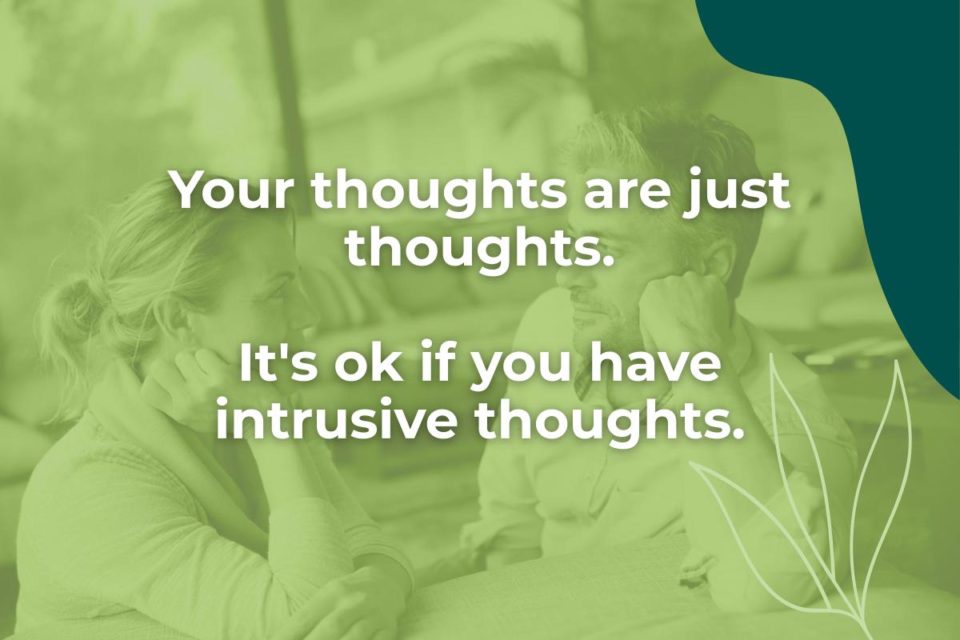
Things that I really want you to take away from this are that your thoughts are just thoughts and that it’s ok if you have intrusive thoughts because putting more pressure on them is going to build anxiety. You can build your toolbox of these things and even if they might not work, sometimes they will work during other times or they can kind of help to decrease a little bit at a time. But with anxiety, a little bit of decrease is still super helpful.
I have generalized anxiety disorder, ADHD, and most recently PTSD, which has been a really fun ride. It’s also something that I’m kind of working through. I know that sometimes it can be so hard but some of these things can be managed so well. The reason that I told you is that when you start practicing them hard, like go at it for two weeks when you have anxious thoughts, you will pick up how to be able to do it in your head more, more quickly, and then it can just be so helpful and you can eventually learn to be really good at that in a way.
Let’s say my thing was catastrophizing and that was the thought I wanted to work on. If I focused on that one, eventually, I might not have so much of an issue with that. Or sometimes I will and sometimes I won’t be able to manage those considerably more.
Is OCD different from generalized anxiety?
OCD is different from generalized anxiety, and so that’s why I said when I was reading the OCD book, it still had a lot of helpful tools. But there are other books for generalized anxiety that you can get specific. OCD is a little bit different because if you were having an intrusive thought with generalized anxiety and then you also had an obsessive thought, you might not have the compulsion to do something about it. People with OCD might feel like if they did something, then they would be able to prevent something from happening.
So it’s a little bit different. But at a baseline, that’s the way it is. Definitely more complicated than that. If you’re looking for someone from Eddins Counseling Group who might be able to help you with that, contact Kristen Gallien, she’s on our website. She specializes in that and she’s awesome. That might be somebody to look into.
It is possible to do EMDR virtually, that’s something that we’ve been transitioning to in this period. It’s a little bit different because we might not use eye movements and sometimes eye movements are more effective for people, but we can use tapping or we can use different kinds of tools. So if you wanted to try doing that and then it didn’t work you this way, maybe we could figure out how to do eye movements later. But that’s totally outside the realm of something that I’m doing with clients right now. And it seems like it’s going pretty well, so that’s good.
Does OCD or anxiety cause mood changes?
ADHD, anxiety, OCD, and all of these things really affect our mood because our thoughts affect our mood and also because sometimes our brain is just able to send us signals so that we’ll be in a terrible mood for however long, and for whatever reason that it does that. And so all of those are definitely very impacted by mood, irritability, and all kinds of stuff.
How often do your clients take medication for anxiety, learn to work through it, and if they can get off the medication?
That is on an individual basis and I honestly don’t have a number for it. Your decision to take medication is definitely up to you. If you feel like you get to a place where you kind of wants to try things with that, then you should definitely talk to your psychiatrist. People are able to work through these things and then they feel better. And so then maybe they want to talk to them. I would never suggest getting off of whatever medication that you’re on for anxiety.
I mean, management with both can be the most effective, if that’s something that you’re trying to do. It’s not something impossible. It is something that people do. I would just make sure that that’s the greatest choice for you. And that would be something to talk to your counselor or to your psychiatrist about.
People who take SSRIs don’t have to take them for the rest of their life.
I fully intend to because I feel way better when I do take it. I’m not sure how I’m going to go when I’m 50, but right now that’s where I’m at.
The Serotonin Power Diet / Anti-anxiety diet
As far as a special diet that helps anxiety, I haven’t really run into anything. I read a book one time called “The Serotonin Power Diet” that had to do specifically with people who experience weight gain after taking SSRIs for anxiety or how to possibly manage some of that because of SSRIs.
I haven’t tried that anti-anxiety diet, so I’m not sure if that one has worked, but it could be something I’ll try next because I like to try all kinds of things. If there’s something that you want to try, I would first do a little bit of research to see where that information came from, to make sure that it’s evidence-based, and then check with your doctor, and then your anxiety treatment is definitely your own.
Considering Anxiety Treatment?
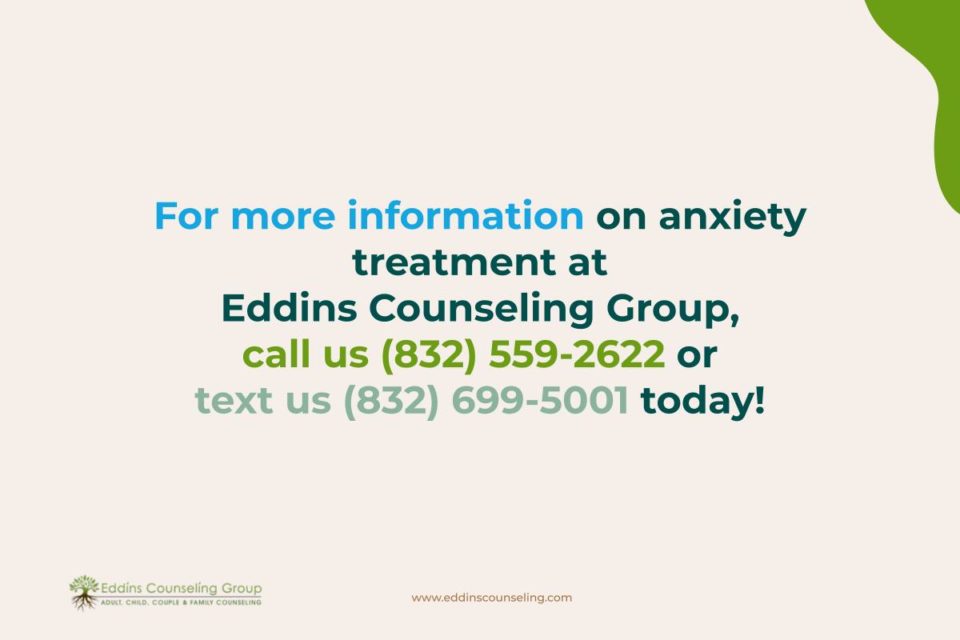
I want to thank you all so much for coming in, attending, and for participating. It was a lot of information on anxiety and social anxiety and if you’d like to make an appointment with me or with any of the other counselors, you can do that through the online portal. I think some of you may already be clients, which is awesome. And if you would like to be, you can do that.
You can also go to the website and then email us using the email address at the top of the page if you like to talk about booking appointments.
We are a team that’s here to support you in whatever it is that you would need.
Again, I want to thank you all for joining me today.
5 Ways to Reduce Anxiety
Get instant access to your free ebook.
Grounding & Self Soothing
Get instant access to your free ebook.
Create Healthier Thoughts & Feelings
Get instant access to your free ebook.
Why You Feel This Way
Get instant access to your free ebook.








